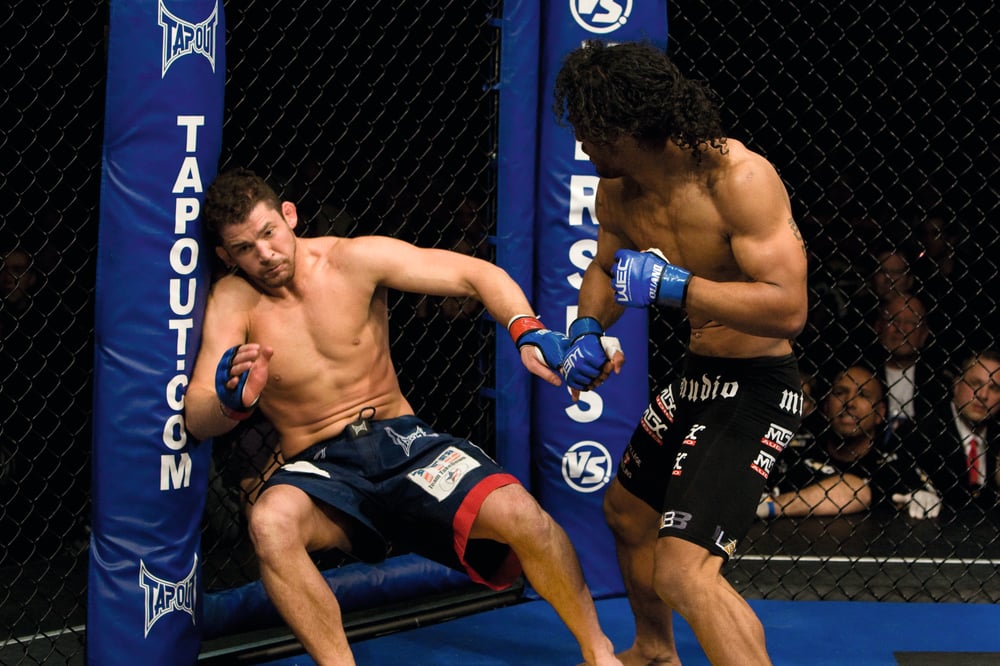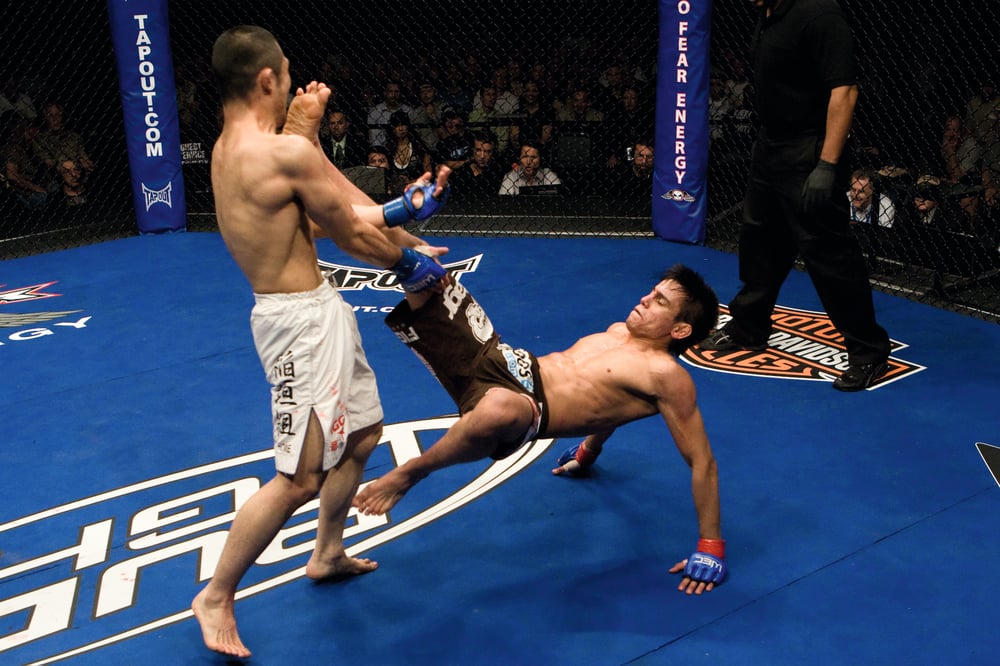
Issue 052
July 2009
One often hears the saying, “Second place is the first loser”. While these words may ring true in many situations, they definitely do not apply in the case of World Extreme Cagefighting (WEC).
Regarded by many as the world’s second biggest MMA promotion, WEC enjoys a very special place in the global MMA landscape. While Affliction, Strikeforce, DREAM and other organizations must always be wary of the top dog (the UFC), the same does not apply to WEC.
Why? Because since 2006, the Las Vegas-based promotion has been owned and run by Zuffa (the parent company of the UFC), making it the sister organization of the most successful MMA promotion in history.
Originally serving as a feeder league for the UFC, the WEC has evolved greatly over time. Today, it is a strong individual brand that delivers an experience very different to that of its sister promotion. For one, WEC doesn’t feature the same weight classes. Following its purchase by Zuffa, all WEC weight classes above lightweight (155lb) were dissolved, shifting the focus of the organization to lighter fighters. Instead of competing against the UFC, WEC compliments it, adding to the Zuffa package of MMA.
The decision to eliminate all shared weight-classes proved to be very fruitful, as the WEC now boasts the world’s most impressive roster of featherweight (145lb) and bantamweight (135lb) fighters, with a brand new 125lb flyweight class also in the works. Simply put, WEC has become the premiere destination for fighters under 155lb.
“Our niche is lightweight fighters,” says founder and managing director Reed Harris. “Our goal is to be a standalone brand, number two in the world, and not to be perceived as a farm league for the UFC. We can say that this is definitely happening. Just look at the popularity of someone like Urijah Faber.”

Casual MMA fans may not have been familiar with the names of top-tier featherweights and bantamweights in the past, but this is quickly changing thanks to WEC stars such as Faber, as well as bantamweight champ Miguel Torres and featherweight titleholder Mike Brown. Though their names are becoming increasingly popular with fans in the US, it’s the new emerging markets that Harris is particularly keen on.
“Of course, there are still new markets for us within America,” says Harris. “But we’re getting huge ratings in Mexico, where fights at lighter weights are really popular. That’s somewhere we definitely want to go and put on shows. In a few years, Asia, particularly Korea, is also a possibility.”
WEC matchmaker Sean Shelby is also excited at the prospect of WEC going international, as this will add a new dynamic to the promotion’s talent pool. “There’s so much talent out there,” says Shelby. “There’s Mexico, which has a history of producing great lighter weight fighters. But there’s also untapped markets like Korea, where’s there’s some amazing bantamweight and flyweight talent, with no real stage. I’m really excited about the prospect of Korea.”
Most recently, the WEC name has been spreading like wildfire in Japan, where in the past, promotions like Shooto were well known for producing some of the world’s best lightweights, featherweight and bantamweights.
WEC’s non-exclusive signing policies have allowed Harris and Shelby to open up new lines of communication with top fighters from the Land of the Rising Sun. “We’ve been in contact with a lot of Japanese fighters,” says Shelby. “So many of them want to head over here and fight for us. We don’t believe in tying fighters down, and I think that really helps.”

However, Shelby admits that there are still numerous challenges faced by his organization, many of which are far greater than those faced by its sister company. For one, there’s the challenge of getting casual American fans to become interested in bantamweight and featherweight match-ups in the first place.
“Often lighter weight fights are harder to sell,” says Shelby. “If you look at boxing, historically the heavyweights are a bigger draw. The casual fan prefers to see light-heavy or heavyweight fighters bang it out.”
Shelby’s theory largely applies to MMA, where names like Chuck Liddell, Tito Ortiz and Randy Couture have attained legendary status, while their lightweight counterparts are still somewhat masked by obscurity. However, as the sport continues to achieve mainstream exposure, Shelby expects that casual fans will become increasingly familiar with the names of lighter fighters as well.
“Going back to boxing,” says Shelby. “In the last five years, it’s been the De la Hoyas, the Mayweathers, the Hattons that are making the big draws. It’s going to be the same story with MMA. Fans are realizing that lighter weight fights are incredibly exciting. The level of speed, agility and technicality is amazing. You just don’t see that at 205lb and above. Joe Rogan once said that watching a good featherweight fight is like watching a ballet of violence. I’d like to add to that, it’s like watching a ballet of violence between two Tasmanian devils.”
“The challenge is in getting them to watch it the first time,” adds Harris. “Once they’ve seen it, they’re hooked, and they’ll keep coming back. It’s just that initial skepticism that they need to get over.”
Women’s MMA is another area that WEC brass have been investigating. With the demise of EliteXC, female fighters like Gina Carano have been in a perpetual state of limbo, with no organization truly championing their cause (at least not in a sustainable, long-term way). Although UFC President Dana White has voiced mixed feelings regarding women fighting in the Octagon, Harris and Shelby seem quite open to the idea, provided that a few conditions are in place.
“We’ve been talking about women’s MMA,” says Harris. “If WEC were to do that, I would insist all fighters make weight. I would run it like a men’s division, with no catch weights. We see a lot of fights with big weight differences in women’s MMA. It’s unprofessional, and could be unsafe.”

While it could be some time before fans see women’s MMA under the WEC banner, Harris assures fans that the option is under serious consideration. “Starting a new weight-class means you need a deep talent pool,” explains Harris. “We were able to open up a 135lb division because the talent was there. 125 is deep too, you wouldn’t believe how much great talent there is at that weight. We have yet to see how deep the talent pool is in various women’s weight classes. If we’re going to do women’s MMA, I want to do it right.” “A division can’t be built around one fighter,” adds Shelby. “Women’s MMA definitely has a couple of big stars, but is that enough to build a weight class?”
So what can fans expect from WEC in the coming months? Pay-per-view events seem to be on the agenda. Although the organization already has a broadcast deal with the US-based Versus Network, 2009 will bring an unknown number of pay-per-view events to North America, and eventually the rest of the world. Furthermore, Harris and Shelby plan to put on live shows throughout the U.S, with international events not too far behind.
Whether or not WEC attains a UFC-level of success is yet to be determined, regardless, the company has come an unbelievably long way, and has sustained an impressive growth, while the likes of Elite XC, the IFL and others have come and gone. “When we started this up [in 2001], we had no long-term goal,” reminisces Harris. “We just wanted to do well enough to put on a second show. There was no help from the media, and we had a very nervous venue. They all thought the event would turn into a riot. We really had no idea how things were going to go, and we were nervous too. Luckily, it all worked out, and over the years we’ve really come a long way. Zuffa buying the WEC was a great decision. It’s because of that, that I can confidently say that we’re number two in the world.”

But with the UFC being number one, will WEC ever find a way to step out of the world’s most popular MMA organization’s shadow? “Realistically it’s hard not to be in the UFC’s shadow,” says Shelby. “We only do eight shows or so a year, while they do at least one a month. But with the shift to lighter fighters, it’s clear we’re no longer a farm-league for the UFC. We’re going to keep growing, and in a couple of years, we’ll be in a lot of countries. Remember, this is Zuffa. We don’t do anything small.”
Up-and-coming stars of the WEC
Jose Aldo
Fast, explosive, well-rounded and with a record of 14-1, Aldo is ranked 6th in the world of 145lb.
Manny Gamburyan
After suffering back-to-back losses in the UFC at 155lb, the scrapper has dropped to his preferred fighting weight of 145lb.
Donald Cerrone
He took lightweight champ Jamie Varner into the fifth round. A former professional rodeo rider, Cerrone lives up to his nickname of ‘The Cowboy’.
...









